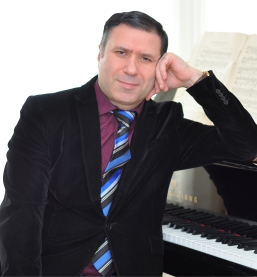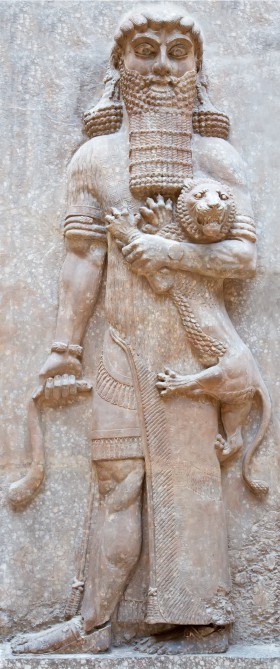Ashot AriyanComposer / Pianist |
Biography

A native of Armenia, he moved to Moscow to continue his education in composition at the Moscow Tchaikovsky State Conservatory, where he graduated with distinction in 2001. A year later, after gaining a master's degree, he became a Teaching Assistant of Prof. Karen Khachaturian at the Moscow Conservatory and taught as a lecturer in Composition and Music Theory.
In 2007, he moved to Canada to complete his doctoral thesis at the University of Montreal, receiving his doctorate in 2013. The goal of his doctoral program was to revive the neglected genre of opera-ballet by writing his own work in that medium, entitled “Bilgamesh” (or “Gilgamesh”), in which the archaic Mesopotamian languages Sumerian and Akkadian are used exclusively.
Ashot Ariyan has taught composition and music theory at several music institutions including the Central Music School of Moscow Conservatory (ЦМШ), Moscow Tchaikovsky Conservatory, the University of Montreal, and McMaster University.
In 1999, to wide acclaim, Ashot Ariyan performed his own “Concerto-Brevis” for piano and orchestra in the Great Hall of the Moscow Conservatory, accompanied by the Russian Philharmonic Orchestra. In 2009 his symphonic fresco “Sounds of Stonehenge” was performed in Montreal by the UdeM Symphony Orchestra. Later, in January 2011, the same work was performed in Armenia by the National Philharmonic Orchestra and in Moscow by the Moscow State Orchestra. His recent work, Planète X (Un train pour l’enfer II) for seven instruments, was performed in Montreal with great success by the Arkea ensemble in November 2013. Many of his chamber works were first performed at the Moscow Autumn International Music Festival. One of his latest works is a Cycle of 12 Fugues and Postludes for piano, commissioned by the Region of Waterloo Art Fund.
In May 2022, a recording company RMN Music has released a “Fugue and Postlude in A” as part of the Modern Music for Piano 4 catalog. In 2016 his music accompanied a presentation of the ballet "Two Suns" directed by Rudolf Kharatian and dedicated to the Centennial of the Armenian genocide. Starting 2020, the ballet "Two Suns" has periodically been broadcast on the Mezzo TV.
Ashot Ariyan has taught composition and music theory at several music institutions including the Central Music School of Moscow Conservatory (ЦМШ), Moscow Tchaikovsky Conservatory, the University of Montreal, and McMaster University.
In 1999, to wide acclaim, Ashot Ariyan performed his own “Concerto-Brevis” for piano and orchestra in the Great Hall of the Moscow Conservatory, accompanied by the Russian Philharmonic Orchestra. In 2009 his symphonic fresco “Sounds of Stonehenge” was performed in Montreal by the UdeM Symphony Orchestra. Later, in January 2011, the same work was performed in Armenia by the National Philharmonic Orchestra and in Moscow by the Moscow State Orchestra. His recent work, Planète X (Un train pour l’enfer II) for seven instruments, was performed in Montreal with great success by the Arkea ensemble in November 2013. Many of his chamber works were first performed at the Moscow Autumn International Music Festival. One of his latest works is a Cycle of 12 Fugues and Postludes for piano, commissioned by the Region of Waterloo Art Fund.
In May 2022, a recording company RMN Music has released a “Fugue and Postlude in A” as part of the Modern Music for Piano 4 catalog. In 2016 his music accompanied a presentation of the ballet "Two Suns" directed by Rudolf Kharatian and dedicated to the Centennial of the Armenian genocide. Starting 2020, the ballet "Two Suns" has periodically been broadcast on the Mezzo TV.
Video
Excerpts of music
Concerto Brevis for piano and orchestra
(extract)
Sounds of Stonehenge
(Symphonic Fresco #2, extract)
String Quartet No1
(extract)
Trio for violin, cello and piano
(extract)
"Amaras" for cello, clarinet and piano
(extract)
Toccata, Intermede and Fugue extract
List of works
|
1989 |
“Children's Pieces” for piano (revised and enlarged in 2015) |
|
|
1991 |
“Ballade” for clarinet and piano |
|
|
1992 |
“Romance” for voice and piano (text by H. Tumanyan) |
|
|
1993-1994 |
Trio for Violin, Cello and Piano |
|
|
1994 |
“Three Taron Songs” for mezzo-soprano and piano |
|
|
1995 |
“Toccata, Intermedia and Fugue” for piano |
|
|
1994-1996 |
"Manfred" - Symphony no. 1 for string orchestra |
|
|
1997 |
“Capriccio” for solo violin |
|
|
1997 |
“Three Pieces” for piano |
|
|
1997 |
"Amaras" for clarinet, cello and piano |
|
|
1997 |
"For Armenia" - poem for a cappella choir (text by V. Brusov) |
|
|
1998 |
"Dedication" for solo cello |
|
|
1998-1999 |
String Quartet |
|
|
1999 |
"Concerto-Brevis" for piano and orchestra |
|
|
2000-2001 |
Symphony no. 2 |
|
|
2002-2003 |
"Skanda" - Symphonic Fresco no.1 for duduk, tape and symphony orchestra |
|
2005-2006 |
"Resonances" for 2 violins, viola, cello, piano and brass quartet |
|
|
2007 |
"Dusk" for cello and piano |
|
|
2009 |
"Sounds of Stonehenge" - Symphonic Fresco no. 2 |
|
|
2009-2012 |
Opera-Ballet "Bilgamesh" (or Gilgamesh) |
|
|
2013 |
Planète X. (Un train pour l'enfer II) for 7 instruments |
|
|
2014 |
“Deus Lucem” for mixed choir |
|
|
2015 |
Cycle of 12 Fugues and Postludes for piano |
|
|
2016 |
“Perpetuum Mobile” for string orchestra |
|
|
2017 |
“Das Grablied” for baritone and piano (text by F. Nietzsche) |
|
|
2019-2020 |
Sonata for Violin and Piano |
|
|
2022 |
String Quartet No. 2 |
|
|
2023 |
"Nashville Nocturne" for piano (commissioned by the Nashville International Chopin Piano Competition) |
|
|
2023 |
"Five Elegant Pieces" for piano |
|
|
2024 |
"Adagio" for String Orchestra |

Bilgamesh or Gilgamesh
Composed between 2009 and 2012, my opera-ballet "Bilgamesh" represents an ambitious project for two special reasons. Firstly, there is the attempt to revive a partially forgotten genre opera-ballet. Secondly, the ancient language of Mesopotamia, Sumerian, and Akkadian are used exclusively. Drawing a parallel with other art forms, one must observe that the blending of singing and dance is more and more gaining a place in popular music, and in contemporary cinema, producers prefer more often the use of little-known but authentic languages to reflect the atmosphere of long-forgotten times. It is my deep conviction that a mythological subject opens up enormous possibilities for the embodiment of the ideas mentioned above, where dead languages can join together with the opera-ballet form in a single organism, strengthening the action on stage with special, sacred thoughts.
The title itself is no accident. The name Gilgamesh is a Babylonian alteration of the original name of the hero, Bilgamesh, in Sumerian.